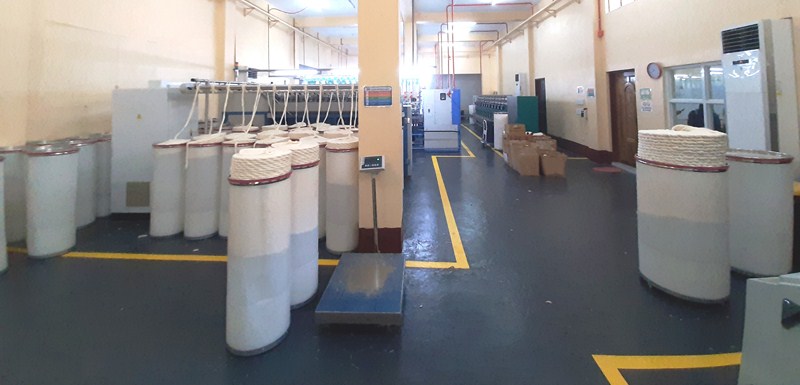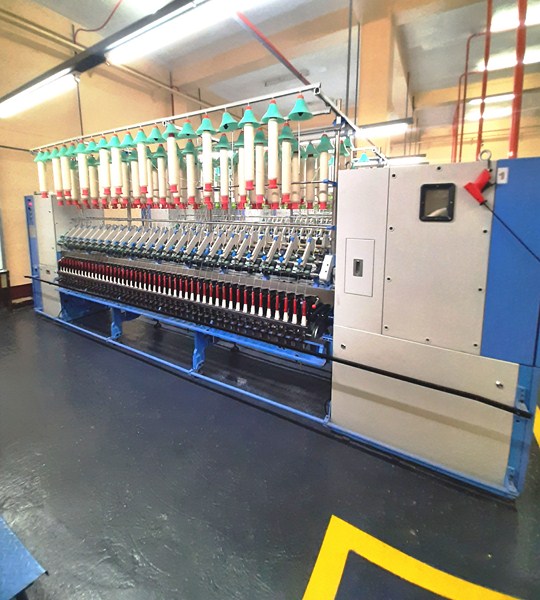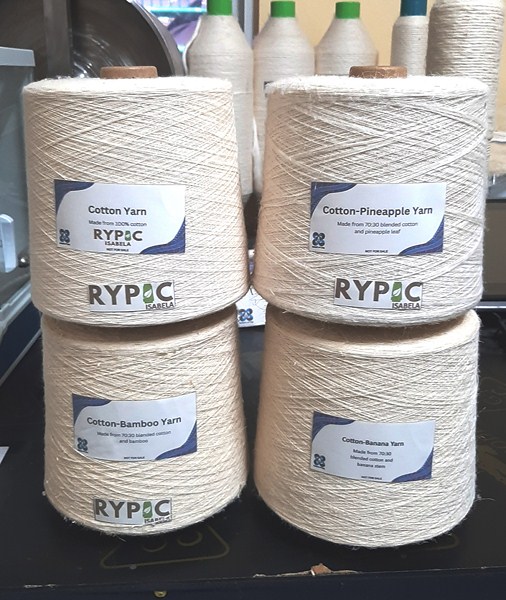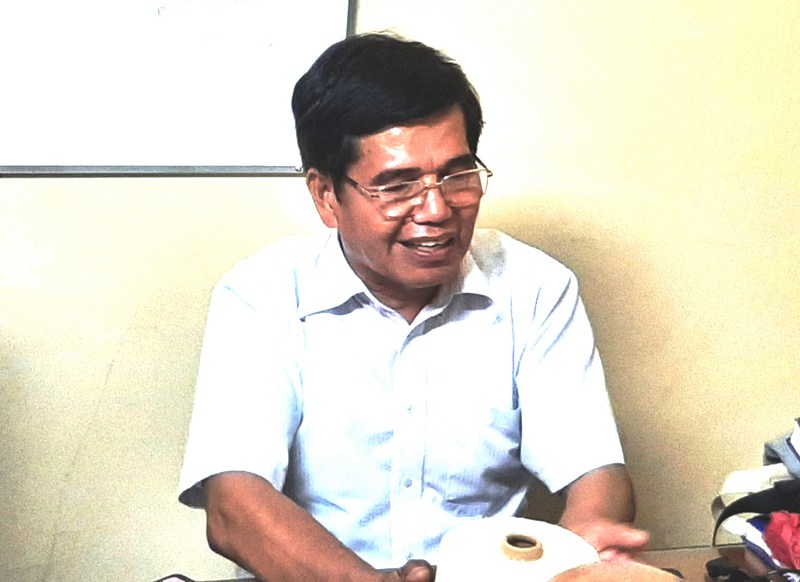The morning of our third day in the City of Ilagan, we visited the Php40 million Regional Yarn Production and Innovation Center (RYPIC) within the City of Ilagan Campus of the Isabela State University. The second of its kind in the country (the first RYPIC is located in Iloilo), it was launched on June 23, 2023 by the Department of Science and Technology-Philippine Textile Research Institute (DOST-PTRI), the Isabela State University (ISU) – City of Ilagan Campus, the DOST-Philippine Council for Industry, Energy and Emerging Technology Research and Development (DOST PCIEERD), DOST Region II, City of Ilagan, and the Province of Isabela.
 InteriorThe establishment of the facility is aimed to strengthen the local textile ecosystem and bridge the gaps in textile supply chain by enabling the conversion of natural raw materials into spinnable fibers for yarns from blends of natural fibers including abaca, banana, bamboo and pineapple leaf, in combination with cotton.
InteriorThe establishment of the facility is aimed to strengthen the local textile ecosystem and bridge the gaps in textile supply chain by enabling the conversion of natural raw materials into spinnable fibers for yarns from blends of natural fibers including abaca, banana, bamboo and pineapple leaf, in combination with cotton.
The RYPIC Isabela is a micro-scale yarn-spinning facility that will aid in the development of the textile industry in Northern Luzon. The facility can produce 50 kgs. of yarn per day (8h) which translates to 270 m. of handloom woven (1 m. width) fabrics. One RYPIC may produce 13,200 kgs. of yarn per year which can be used to produce 36,000 m. of 60″ width fabrics for 24,000 pieces of a female blouse or 18,000 office barong tagalog.
The center, under the DOST-GIA project “DOST Inclusive Innovation Textiles Empowering Lives Anew or i2TELA Program,” the first of its kind in Northern Luzon, processes the treated fibers from the Natural Textile Fiber Innovation Hub (NTFIH), in Luna, Apayao, and the Bamboo Textile Fiber Innovation Hub (BTFIH) in Cauayan City, Isabela, which are spun natural textile fiber-based yarns.
The RYPIC aims to jumpstart local innovation ecosystems for the textile sector and cater to the requirements of micro, small, and medium enterprises (MSMEs) in the fashion industry, the academe, and government institutions for yarns and fabrics using local raw materials, skills, and talents. It serves as an innovation hub to promote textile research and development activities in a region, thus igniting economic activity in weaving communities across the country.
The center is run by the faculty and staff of the Isabela State University who underwent a five-day training, part of the capability-building component of the RYPIC north Luzon project under the “DOST–PTRI Inclusive Innovation TELA (Textile Empowering Lives Anew)” program, at the DOST-Philippine Textile Research Institute (PTRI) in Bicutan, Taguig, learning about textile raw materials and products, the process of textile manufacture, and techniques for testing and evaluating their common properties. They also gained knowledge and skills on how fibers are converted to yarns in the cotton system.
During our visit, we observed, in action, the different equipment used in the yarn production.
- Integrated Blow Card – a combination of blow room and carding machine designed, specifically for scaled-down spinning processes. This machine can function as a blow room. Raw fibers are opened, cleaned, mixed and transported to the carding machines, where mixed fibers are individually oriented and converted into rope-like strands called “slivers.” This is done through the carding action of three major components of the machine –licker-in, main cylinder and doffer.
- Draw Frame – carded slivers go through between the top and bottom drafting rollers; dust and fly wastes are removed by a suction tube, improving the parallelism of the fibers to produce more even yarns. The combination of several carded slivers is called “doubling,” and its output is called a “drawn sliver.”
- Speed Frame (Flyer Frame) – drawn slivers go through between the top and bottom drafting rollers, achieving its required weight to produce the “roving.” The roving material passes through the final drafting rollers, slight twist, enough to hold in the next process stage, is imparted.
- Ring Frame – the roving passes through between the top and bottom rollers, to achieve the required yarn count or yarn number, imparting twist suitable for weaving and knitting, and wound into a bobbin for storage, transport and further processing. The output yarns are expressed, either as weight per unit length (direct system), or length per unit weight (indirect system).
- Single End Universal Sizing – yarns, in cones, are imparted with size (starchy substance) through bathing, drying and rewinding into cones. The purpose of introducing size is to reduce the chances of threads fraying and breaking due to the friction in the weaving process. The size stiffens the thread and holds the fibers closely together.
- Twisting – an intermediate process in the manufacture of fabrics, no alteration is done to the material other than to twist one or more strands of yarn, placing the twisted yarn in suitable packaged form. Twisting compresses the fibers, reducing the size of the strand and adding strength to multiple ends when they are combined.
- Winding – this machine has the capability to function as winder. Yarns, which emerges from the ring frame, are transferred into cone packages. The idea is to obtain a long, continuous length of yarn, for nonstop operation of weaving or knitting, regulate yarn tension and remove thick and thin yarns, slubs by means of a yarn monitoring device.
After our tour of the facilities and prior to our departure, we interviewed Dr. Freddie O. Orperia, RYPIC Focal Person.
Regional Yarn Production and Innovation Center (RYPIC): Isabela State University, 3300 City of Ilagan, Isabela.
City Tourism Office: 2/F, City Hall Bldg., 3300 City of Ilagan, Isabela. Tel: (078) 624-1511. E-mail: tourism@cityofilagan.gov.ph.
City of Ilagan Tourist Information and Assistance Center: Bonifacio Park, 3300 City of Ilagan, Isabela. Tel: (078) 324-7769. E-mail: ilaganinfocenter@gmail.com.
Isabela Provincial Tourism Office: Provincial Capitol Complex, City of Ilagan, Isabela. Tel: (078) 323-3146. Mobile number: (0917) 317-3820. E-mail: isabelatourismoffice@gmail.com.
Isabela Provincial Information Office: Provincial Capitol Complex, City of Ilagan, Isabela. Tel: (078) 323-0248. Mobile number: (0927) 395-7555. E-mail: letters_info@yahoo.com.
How to Get There: The City of Ilagan is located 429.3 kms. (an 8-hour drive) from Manila and 35.5 kms. (a 1-hour drive) from Cauayan City.










